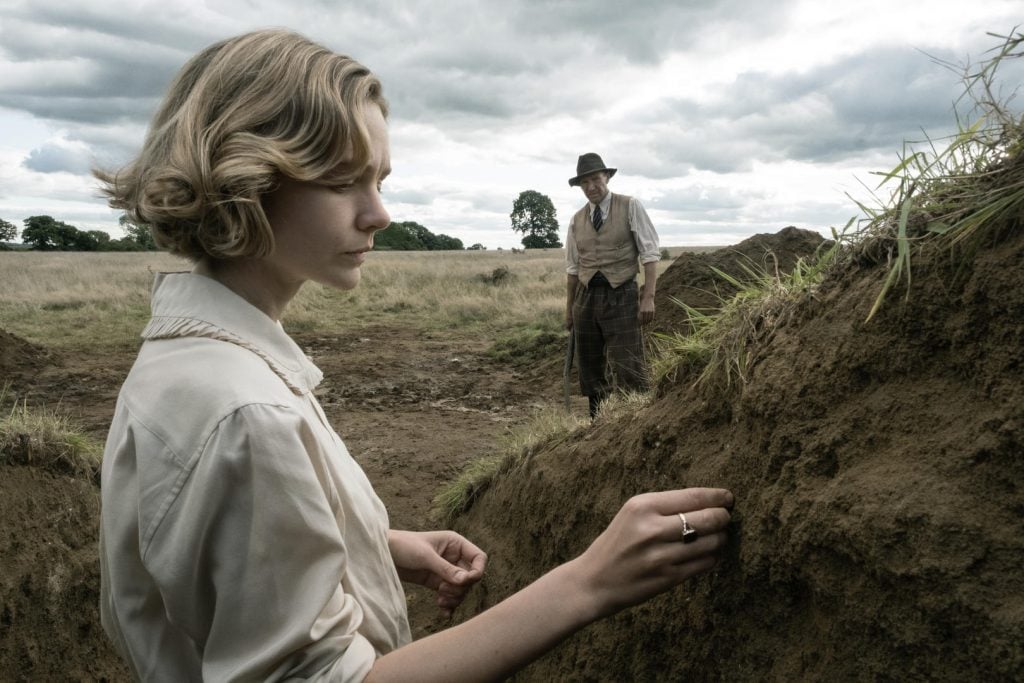Art World
Here’s the True Tale Behind Netflix’s Buzzy New Carey Mulligan Archaeology Drama, ‘The Dig’
The film is triggering new interest in Sutton Hoo.

The film is triggering new interest in Sutton Hoo.

Caroline Goldstein

In the months between May and September 1939, as Britain edged closer to the growing threat of war with Germany, the residents of Sussex, in the Southeast of England were captivated by the events of centuries earlier.
Between the months of May and September of that year, the widowed landowner Edith Pretty was able to undertake the historic unearthing of mysterious mounds on her property that would result in the most momentous excavation of a medieval grave in Europe: the Anglo-Saxon burial at Sutton Hoo.
The true story of the event is dramatized in a new Netflix film titled The Dig, directed by Simon Stone and based on a 2007 book of the same name by John Preston. Preston’s aunt, Margaret Preston, was one of the archaeologists who participated in the dig (played by Mama Mia! Here We Go Again actress Lily James in the movie).
The Dig is a sweeping period drama filled with grand pastoral views and striking sunsets, featuring an all-star cast led by Carey Mulligan, who plays Edith Pretty, and Ralph Fiennes, who plays the amateur archaeologist Basil Brown, who Pretty employs to carry out the titular dig.
As with most Hollywood adaptations, there are some artistic liberties taken in the Netflix jaunt, but the main points of the movie are, incredibly, true. Here’s the real story behind the film.
Edith Pretty was born to a wealthy industrialist family in Yorkshire, and spent her childhood between Manchester and the family estate in Vale Royal Abbey near Cheshire. The Dempster family’s wealth afforded them access to travel, and Edith was particularly impressed by trips to Egypt, the United States, and Greece, instilling in her a curiosity that lasted her lifetime.
Edith’s father Robert Dempster died in 1926. With the money she inherited, Edith bought the land at Sutton Hoo, a 526-acre estate on the River Deben. Freed from familial obligations, at this point Edith accepted a marriage proposal from Lt. Colonel Frank Pretty, who had courted the young woman since her 18th birthday. Edith gave birth to her son Robert in 1930, and just seven years later, Frank died of stomach cancer, leaving Edith as a single mother and vast landowner.
The film opens here, with Carey Mulligan playing the soft-spoken Pretty, still grieving the loss of her husband but invigorated by the prospect of finally uncovering what lay under the huge mounds of earth rising from her property. Pretty hired a local amateur archaeologist named Basil Brown—he repeatedly refers to himself as an excavator—who was recommended by the nearby Ipswich Museum, to carry out the task.
The film portrays their relationship as one of kindred spirits. Both are awestruck by the idea of unearthing the past, and a romantic frisson underlies much of their shared screen time. Brown, played by Ralph Fiennes, was a self-taught polymath who published books on astronomy and spoke several languages.
When he began brushing away the soil, Brown discovered that the trove underneath was more incredible than anyone suspected: it was the burial site of a likely king, interred in a ship that measured 88 feet long, and contained Byzantine silver, finely woven textiles, vessels, and what would become known as the Sutton Hoo Helmet, one of four complete Anglo-Saxon helmets to survive.
Though the objects themselves were a stunning discovery, what they suggested was a vast network of trading, extensive travel, and a sophisticated society that prized fine art and objects. Previously, the so-called “Dark Ages” were so named because historians thought them to be a time of stagnation in Britain. Instead, as a curator declares in the film, “these were not savage warriors, these were sophisticated people with incredible artistry.”
Edith Pretty generously donated the finds from her property to the British Museum. She remains one of its most vaunted donors to this day, according to the Museum. In recognition of her gift, Winston Churchill nominated her for a CBE, though she declined.
As the United Kingdom declared war on Germany, officials rushed to preserve the vast findings, along with other national treasures. They were stored underground for the length of the war—the contents of the dig hidden once more, albeit temporarily.
The British Museum maintains a gallery filled with the wares discovered at Sutton Hoo. The film is streaming now on Netflix.